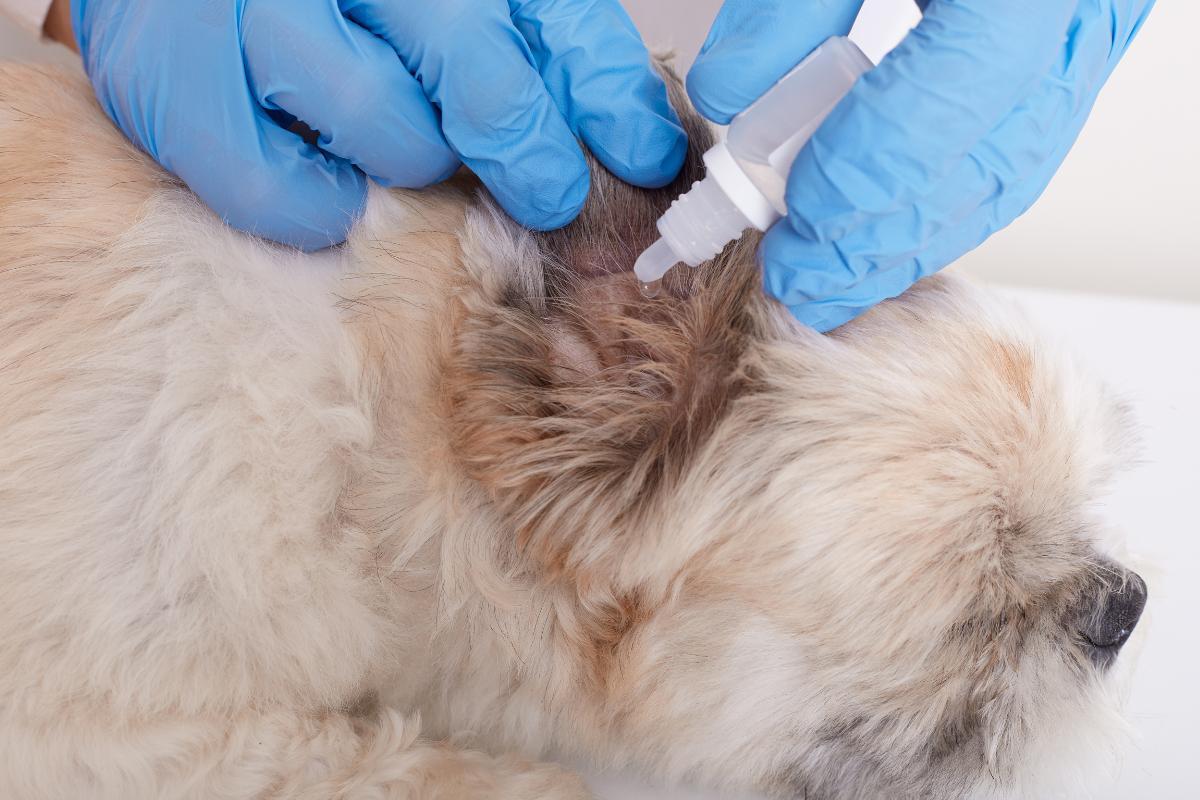What Causes a Dog to Lose Balance?



See files for Dogs
Dizziness, a disorienting sensation that affects humans, can also be experienced by our canine companions. Just like us, dogs can encounter balance issues and feelings of unsteadiness, which can be concerning for their owners. Recognizing the signs, understanding the causes, and knowing how to manage dizziness in dogs is essential for providing them with the care and support they need.
In the AnimalWised article below, we delve into the different conditions associated with dizziness and imbalance in dogs, its causes and treatment.
Cerebellar syndrome
Cerebellar syndrome in dogs occurs when there is dysfunction or damage to the cerebellum, a crucial part of the brain that plays a vital role in coordinating movements and maintaining balance. The cerebellum receives sensory information from various parts of the body and integrates it to ensure smooth and coordinated muscle activity.
Causes
There are several possible causes of cerebellar syndrome in dogs:
- Congenital malformations: some dogs are born with abnormal development or structural defects in the cerebellum. This can be due to genetic factors or intrauterine influences.
- Degenerative diseases: certain degenerative conditions can affect the cerebellum over time, leading to cerebellar syndrome. These diseases progressively damage the cells and tissues of the cerebellum, impairing its proper functioning.
- Tumors: tumors that develop within the cerebellum or in adjacent areas can disrupt its normal function, leading to cerebellar syndrome. These tumors can be benign or malignant and may arise from the cerebellar tissue itself or from nearby structures.
- Infections: in some cases, infections can affect the cerebellum and result in cerebellar syndrome. Infectious agents such as bacteria, viruses, or parasites can invade the cerebellum, causing inflammation and damage to the tissue. Canine distemper virus and neosporosis are examples of infections that can lead to cerebellar syndrome in dogs.
Symptoms
Dogs with cerebellar syndrome typically exhibit characteristic clinical signs that reflect the dysfunction of the cerebellum. These signs may include:
- Unsteady gait or a wide-based stance: Dogs may have difficulty maintaining their balance and coordination, leading to a wobbly or staggering walk.
- Hypermetria: This refers to exaggerated movements, particularly when dogs lift their limbs higher than necessary during walking.
- Intentional tremors: Tremors are typically seen when the dog voluntarily performs movements, especially in the head region. These tremors usually disappear when the dog is at rest.
- Deficiencies in threat response: Dogs with cerebellar syndrome may have impaired responses to threatening stimuli or difficulties in appropriately assessing and reacting to potential threats.
Treatment
The treatment of cerebellar syndrome depends on the underlying cause. While some causes, such as congenital malformations, may not have specific treatments, supportive care can be provided to manage the symptoms and improve the dog's quality of life.
In cases where a treatable cause, such as an infection or tumor, is identified, targeted therapies like medication or surgery may be recommended to address the primary issue.
It is important for owners to consult a veterinarian if they suspect their dog is experiencing cerebellar syndrome or any other balance and coordination issues. A thorough examination and diagnostic tests will help determine the cause of the syndrome and guide appropriate treatment strategies to support the affected dog.
Do not miss this other article on why your dog walks like he is drunk.
Peripheral vestibular syndrome
Peripheral vestibular syndrome in dogs refers to dysfunction or inflammation affecting the peripheral components of the vestibular system, which includes the inner ear and the vestibular nerve.
Causes
This condition can arise from various causes and often results in significant balance disturbances and associated symptoms. Here are some key aspects to consider regarding peripheral vestibular syndrome:
- Ear Infections: bacterial or yeast infections in the middle or inner ear can lead to inflammation and disruption of the vestibular system. These infections may be secondary to allergies, foreign bodies, or other underlying conditions.
- Trauma: head injuries or blunt trauma to the head can damage the structures of the inner ear, causing peripheral vestibular syndrome.
- Idiopathic factors: in some cases, the specific cause of peripheral vestibular syndrome may remain unknown. This is referred to as idiopathic vestibular syndrome, which typically occurs spontaneously without an identifiable trigger.
Symptoms
Dogs with peripheral vestibular syndrome often exhibit distinct signs that reflect the disruption in their balance and coordination:
- Sudden onset of symptoms: the onset of peripheral vestibular syndrome is usually rapid and unexpected. One day, the dog may appear normal, and the next, they may display severe balance issues.
- Head Tilt: a noticeable tilt of the head is a common symptom. The dog may tilt their head to one side or hold it at an angle.
- Nystagmus: rapid and involuntary eye movements, known as nystagmus, are often present. These eye movements may be horizontal, vertical, or rotary in nature.
- Unsteady gait: dogs with peripheral vestibular syndrome may have a pronounced lack of coordination, resulting in a staggering or wobbly gait.
- Asymmetric facial expression: facial weakness or drooping on one side of the face can occur due to the involvement of the facial nerve, which is connected to the vestibular system.
Treatment
The treatment of peripheral vestibular syndrome focuses on managing the underlying cause and providing supportive care to help the dog recover. Treatment options may include:
- Medications: anti-inflammatory drugs or antibiotics may be prescribed to address ear infections or reduce inflammation within the vestibular system.
- Symptomatic support: supportive care involves providing a calm and stable environment for the dog, as well as assisting with mobility and preventing injuries.
- Nutritional support: ensuring the dog has access to food and water and maintaining proper hydration is essential during the recovery phase.
- Time and rehabilitation: in many cases, peripheral vestibular syndrome resolves spontaneously over time, and the dog gradually regains their balance. Rehabilitation exercises and physical therapy may aid in the recovery process.
It is crucial to consult a veterinarian if a dog shows signs of peripheral vestibular syndrome. A thorough examination, including diagnostic tests to identify the underlying cause, will help determine the most appropriate treatment plan and ensure the best possible outcome for the affected dog.

Central vestibular syndrome
Central vestibular syndrome refers to dysfunction or damage to the central components of the vestibular system, which include the brainstem and the cerebellum.
Unlike peripheral vestibular syndrome, which primarily affects the peripheral structures of the vestibular system, central vestibular syndrome involves problems within the central nervous system itself. This condition can result from various causes and often leads to significant disruptions in balance and coordination.
Causes
- Brain Tumors: tumors that develop within the brain, particularly in areas associated with the vestibular system, can cause central vestibular syndrome. These tumors may be primary brain tumors or metastatic tumors from other parts of the body.
- Inflammatory or infectious diseases: certain inflammatory or infectious conditions affecting the brain, such as encephalitis or meningitis, can lead to central vestibular syndrome.
- Vascular disorders: stroke or other vascular incidents that affect the blood supply to the brain can result in central vestibular syndrome.
- Degenerative diseases: progressive degenerative conditions, such as cerebellar abiotrophy or neurodegenerative disorders, can cause dysfunction within the central vestibular system.
Symptoms
Central vestibular syndrome often presents with a combination of symptoms related to impaired balance, coordination, and other neurological deficits:
- Loss of balance and coordination: dogs with central vestibular syndrome may exhibit severe difficulties in maintaining balance, resulting in a staggering or falling gait.
- Head tilt: a noticeable tilt of the head may be present, similar to peripheral vestibular syndrome. However, the head tilt in central vestibular syndrome may not be as pronounced or consistent.
- Abnormal eye movements: dogs may display abnormal eye movements, such as horizontal or vertical nystagmus, that are different from the rapid eye movements seen in peripheral vestibular syndrome.
- Altered mentation: central vestibular syndrome can cause changes in a dog's behavior or mentation, including disorientation, confusion, or altered consciousness.
- Other neurological signs: depending on the underlying cause, additional neurological abnormalities may be present, such as weakness, seizures, or abnormal reflexes.
Treatment
Treatment options for central vestibular syndrome primarily depend on the underlying cause and aim to manage the specific condition contributing to the syndrome. Approaches may include:
- Medical management: treatment may involve medications to address the underlying cause, such as anti-inflammatory drugs for inflammatory conditions or antiepileptic medications for seizures.
- Surgical intervention: in cases where a brain tumor or other surgical conditions are causing central vestibular syndrome, surgical removal or intervention may be necessary.
- Supportive care: similar to peripheral vestibular syndrome, providing a stable and stress-free environment, assisting with mobility, and ensuring proper nutrition and hydration are essential for the dog's overall well-being.
As central vestibular syndrome can have various causes and associated complications, it is crucial to consult with a veterinarian promptly. A thorough examination, including diagnostic tests such as imaging studies (e.g., MRI) and bloodwork, will help identify the underlying cause and guide appropriate treatment strategies.
Early intervention and management of the underlying condition are vital for the best possible outcome for dogs with central vestibular syndrome.
We've written another article that you might find interesting. It covers feline vestibular syndrome in detail, including the causes, symptoms, and treatment options.
This article is purely informative. AnimalWised does not have the authority to prescribe any veterinary treatment or create a diagnosis. We invite you to take your pet to the veterinarian if they are suffering from any condition or pain.
If you want to read similar articles to What Causes a Dog to Lose Balance?, we recommend you visit our Neurological diseases category.






